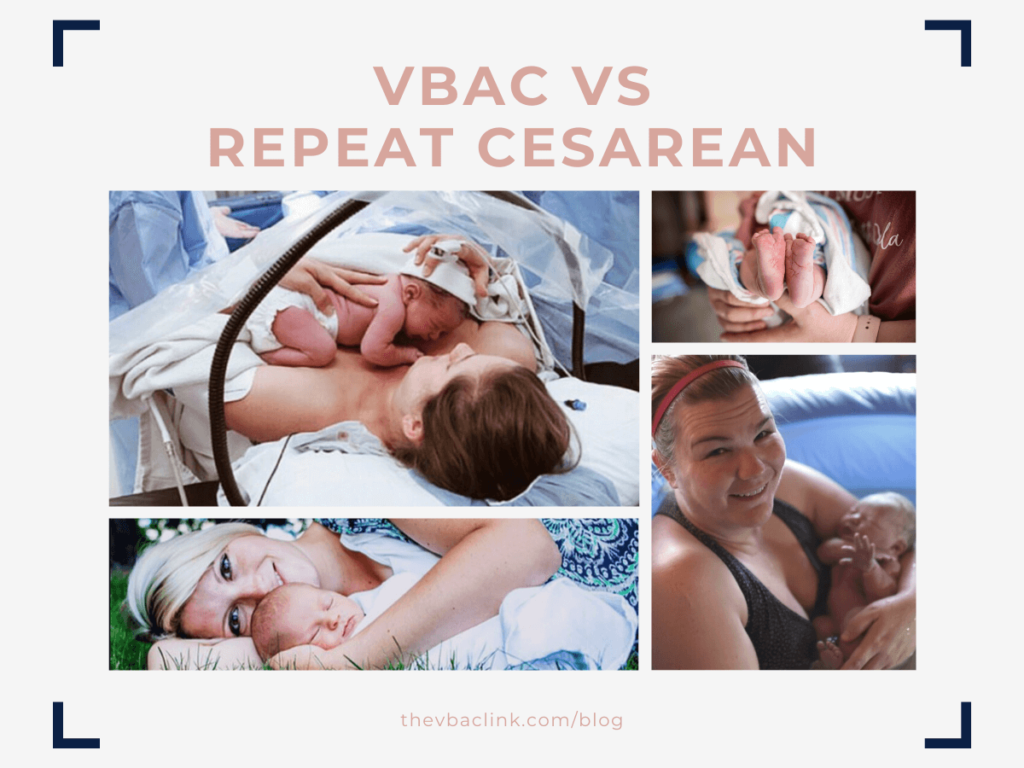Whether to have a VBAC vs repeat c-section is a common question that birthing parents ask themselves. It can be hard to know what to do, what is best, and to sift through all of the information and misinformation that is on the internet.
First things first, if you are deciding between a vaginal birth and scheduling a repeat c-section, I highly suggest you gather as much evidence-based information as you can, take a VBAC course, and then follow your intuition.
Remember, no matter what route you take, the most important thing is that you do what is best for you. Neither VBAC nor repeat c-section is a bad option. You are still giving birth to a sweet baby.

Is VBAC Safe?
It can often feel like no one cares why the cesarean rate is so high. We get emails every week, asking why the attitudes towards the safety of VBAC have changed so much over time.
With knowledge comes power, so we want to give you a brief history of VBAC in the U.S. for a better understanding of why the general attitude is the way it is right now.
In 1916, an obstetrician by the name of Dr. Cragin wrote an article for the New York Times Medical Journal on VBAC titled “Conservatism in Obstetrics”.
This article, published more than 100 years ago, is where the phrase “Once a Cesarean Always a Cesarean” came from.
However, Cragin also points out that “many exceptions occur,” and that even one of his own patients had gone on to have three vaginal births without difficulty after an initial cesarean birth.
Since then, technology has evolved and cesarean sections have become easier and safer. Where the rates of cesarean used to be 5%, they are now 32% as of 2017.
The overall VBAC success rate today is higher than ever.
Evidence-Based Birth®, a blog about the research on VBAC and other birth choices, points out that there are really not many studies on the evidence of VBAC. You truly have to determine through your own education and your heart whether or not VBAC is the right option for you.
According to current VBAC facts and recommendations from the ACOG, it is considered safe for those who are good candidates. And, as discussed in our article all about VBAC success rates, most women who want a VBAC are successful.
Pros and cons of scheduling a repeat cesarean
There are pros and cons to scheduling a repeat c-section. In fact, some parents schedule a c-section after a previous vaginal birth, due to birth trauma they had experienced in the past.
One benefit to a scheduled or repeat c-section is knowing exactly when you are going to have a baby. The waiting game at the end of your 9 month pregnancy journey can be emotional and exhausting on many levels. For some, eliminating the unknown of when the baby will come can bring comfort and take away that stress.
In addition to being able to plan for the exact day, some parents find comfort in having some familiarity with what to expect during the cesarean birth.
Reasons why parents may want to schedule a repeat c-section
- Convenience of knowing when the baby will come and being able to schedule their birthday
- Uncomfortable with the fear of the chance of uterine rupture
- The unknown territory that comes with vaginal birth
- The certainty of already knowing what a c-section looks like
- Unaware that a VBAC is an option at all
- Fear of the pelvic floor being damaged
Reasons why a provider may suggest a repeat c-section
We have many people write to us on The VBAC Link Instagram saying that their provider is suggesting they have a repeat c-section vs go for a VBAC.
Providers may suggest a c-section for some of these reasons:
- During the previous birth, the cervix did not progress (Failure to progress)
- Baby didn’t descend after hours of pushing, or diagnosis of a large baby
- Last birth was a “failed” assisted/operative birth that went to an unplanned C-section
- Diagnosis of CPD (small pelvis)
- The birthing parent has reached 39 weeks gestation and is not dilated
- The risk of uterine rupture can be a large concern for providers

Pros and cons of deciding to VBAC
Just like having a C-section has pros and cons, there are also pros and cons surrounding the choice to VBAC. Whenever parents are placed in the position of making a choice, it is highly encouraged that they learn both the disadvantages and advantages of each side.
The pros may not outweigh the cons of a VBAC for someone, while for others, the pros may trump the cons.
Pros of going for a VBAC
There are many benefits to having a vaginal birth, but it is more common these days for providers to talk about the risks of VBAC more than the benefits.
When you are interviewing providers, if they do not share both the risks and benefits of repeat c-section and VBAC, that could be a red flag. Don’t hesitate to ask for both the advantages and disadvantages of both VBAC and scheduling a repeat c-section.
These are some of the potential benefits of VBAC:
- Avoiding a major surgery
- Lower rate of maternal death
- More natural approach
- Quicker recovery
- Shorter hospital stay
- Avoiding future adhesions caused by cut or nicked bladder, bowel, and uterus
- Baby receiving natural microbiome
- Decreasing the chances of hysterectomy
- Decreasing the chances of blood transfusion
- Breastfeeding may be established sooner
Cons of VBAC
- The chance of uterine rupture that occurs in less than 1% of birthing people
- Potential pelvic floor damage
- Potential for traumatic birth experiences
- The unknown of when a baby may arrive
- Induction is less ideal and sometimes can be harder if the cervix is not ready

Deciding to VBAC or not: Putting risks and benefits into perspective
This may be one of the hardest decisions for birthing couples to make. For me personally, after doing the research and learning the pros and cons, I decided that VBAC was the best choice — for myself, my baby, and my family.
With this being said, I want to remind you that there is no right or wrong way to give birth, as long as it is the best way for YOU.
Something to consider when deciding whether or not to VBAC or go ahead and schedule a repeat c-section includes thinking of how many children you want. With every c-section, there comes the risk of placenta previa, hemorrhage, and risk of needing a hysterectomy.
There are also risks for the baby, which include being cut when the provider makes the incision into the uterus, not getting the natural microbiome from the vaginal canal, increasing chances of allergies, and more.
After my second C-Section, the recovery was much harder than the first. It was hard for me to care for my older child, especially in the first few weeks as I was recovering and placed on restrictions. I was not able to lift over 10 lbs, take a bath, get in and out of bed easily, drive my car, or even laugh with ease.
I struggled, wanting to do things like play with my daughter and take her to the park, but I just didn’t physically or emotionally have the strength.
In addition to c-section recovery being difficult for me, it put a lot of pressure on my husband. He had to take care of the house and my oldest child, while also taking care of me. I was unable to stand in the shower for long, get comfortable in bed, or get my baby at night when it was time for her to eat.
Although c-sections have their downsides, there are also some benefits in scheduling them, whether necessary or desired. Scheduling your birth may be something you really want. Not being in labor before going into the operating room can make things easier for the provider because the uterus is calm vs contracting.
Some of our Instagram followers have reported that recovery for their c-section was better than their vaginal birth. This is totally possible — vaginal birth recovery is not always a walk in the park.
With vaginal delivery the pelvic floor can sometimes be affected. Pushing for long periods of time can take a toll on the pelvic floor, causing incontinence or even prolapse. Tearing can also cause scar tissue that may need to be massaged out later or tear again in future deliveries.
Seeing a pelvic floor specialist before the baby arrives is a great way to help avoid this trauma to the pelvic floor. Although rare, it is also possible to tear and have bowel incontinence.
Overall, recovery for a vaginal birth is typically quicker and easier. If that’s what you decide, there are some things you can do to improve your chances of having a successful VBAC.
To help you determine if planning a VBAC vs repeat c-section is best, consider some of these questions.
Do you have a high-risk pregnancy?

Determining if you have a low or high-risk pregnancy may help you decide whether or not to move forward with a VBAC birth plan. Having a previous c-section does not automatically make you high-risk, nor does being plus-size and pregnant.
Even if you are considered high-risk, this does not necessarily mean you can’t VBAC. I encourage you to discuss your risk factors with your healthcare professional and decide what is best for you and your family.
You may be considered to have a high-risk pregnancy if you have tested positive for gestational diabetes, or were previously diagnosed with type 1 or 2 diabetes. You may also be considered high-risk if you are carrying more than one baby, have a higher BMI, have had multiple c-sections, or have a scar other that is not low transverse.
It is never a bad idea to get multiple opinions if you are diagnosed as high risk and you have questions, or would like to still consider a VBAC vs a repeat c-section.
Are you generally healthy?
Nutrition and physical activity are important in any pregnancy. ACOG suggests that a pregnant person gets in 30 min of physical activity a day. We have put together a VBAC pregnancy nutrition article all about what nutrients you need to receive during pregnancy. Our bodies naturally will perform better, especially during labor, when they receive the best nutrition.
During pregnancy our babies are taking a lot of nutrients from our bodies which means it’s even more important to fuel our bodies by staying healthy and fit.
How many cesareans have you had?
Have you had one, two, three, maybe even five c-sections? The number of c-sections that you have previously had may be something to consider. If you’ve had multiple c-sections, it may be harder to find a VBAC supportive provider. But it’s not impossible.
With more c-sections, you may be at a higher risk for uterine rupture. It is suggested to receive your own OP reports and discuss with your provider the benefits and risks for both VBAC and repeat c-section.
It is possible to have a vaginal birth after multiple cesareans (VBAMC), and in fact, many birthing people have had VBAMC. Just keep in mind, as always, you’ll have to decide with the support of your provider if the risk that comes with VBAMC is right for you.
What type of c-section scar do you have?

If you have had a previous c-section, discuss your previous birth(s) with your provider to determine what type of scar you have on your uterus. These days, most providers perform a traditional horizontal incision, low in the bikini area. However, there are other types of uterine incisions that may be performed. These are called “special scars”.
Although studies show that pregnant people do not have any significant increase in rupture, providers may be less likely to support TOLAC for birthing people with a special scar. This leaves birthing parents frustrated and feeling a lack of support.
Choosing VBAC or C-Section with confidence
While Julie and I were preparing for our own VBAC babies, we were left searching for information on both scheduling a repeat c-section vs going for a vaginal birth. There was plenty of information online and in social media, but it was hard to decipher between the facts and myths.
The number one reason we created The VBAC Link was to help all of you who are in the same place we were years ago. We want to make it easier to find the evidence and facts surrounding VBAC all in one place.
If you would like to learn more about the history of c-section, VBAC, and the differences between the two, check out our VBAC prep course for parents. And as always feel free to email us with any questions.














 The Truth about the VBAC Success Rate
The Truth about the VBAC Success Rate
Aloha, have you ever experience or know someone who experienced Shoulder Dystocia with first born and had to have an ER C section I have a low across bikini cut I not sure if the inside is up down or across also I got pregnant 6 months after my previous c section with my daughter I am currently 25 weeks and in July 15 my daughter will be 1 please help me or advice me what will be best option for me to do😩
Am I able to give VBAC ?